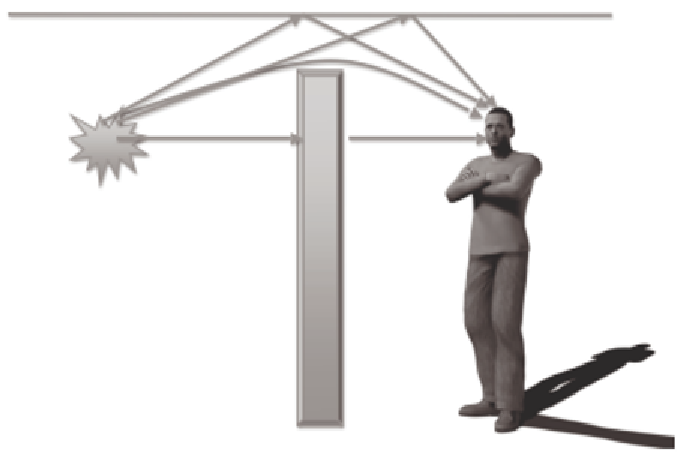Information Technology Reference
In-Depth Information
Figure 7. Sound is transmitted to the listener on the other side of an occluding barrier via through and
around the barrier, as well as reflected from surfaces such as a ceiling
in thunder that is quite rich in both high and low
frequencies. However, if the listener were much
further from the source, only the low frequencies
would survive the distance.
Most gameplay occurs on or close to the vir-
tual ground where sound is reflected back to the
listener at varying rates depending on the surface
type. Some other factors that can influence outdoor
sound propagation at ground level are things such
as low-lying mist or fog. These conditions alter
the sonic properties of the outdoor environment,
with the effect of increasing the apparent loudness
of distant sounds. This phenomenon is caused
by a temperature irregularity, where cold air is
closer to the ground than warm. This forces some
sound-waves to bend back towards the ground
at the point of temperature inversion (from cold
to warm), instead of propagating upward and
diminishing. See Figure 8a and 8b. However,
an opposing factor in such an environment may
also come into play where some sound may be
attenuated or muffled due to humidity levels in
the low-lying fog.
Furthermore, ground level gameplay may also
incorporate wind elements that also have an effect
on sound-wave direction. Sound may be carried
toward the listener if they are positioned downwind
or they may have difficulty hearing the sound in
cases where they are upwind (see Figure 8c).
Slopes and valleys also have an effect, as do
ground surfaces themselves. For example, grass
surfaces do not tend to affect frequencies below
100 Hz, but can seriously attenuate higher fre-
quencies up to 40dB/km at 1 kHz (Fletcher, 2004).
Similarly, trees and foliage scatter mid to high-end
frequencies also, whilst their effect on low fre-
quencies is minimal.
In relation to super-hero characters capable
of flying well above ground level, similar effects
in terms of sound propagation would also occur.
These effects are predominantly due to tempera-
ture change (getting colder with increased height)
and as the character flies further upward, colder
temperatures slow the speed of sound (the dif-
ference being as much as 10% between ground
level and 10000 meters) (Fletcher, 2004). Other

Search WWH ::

Custom Search